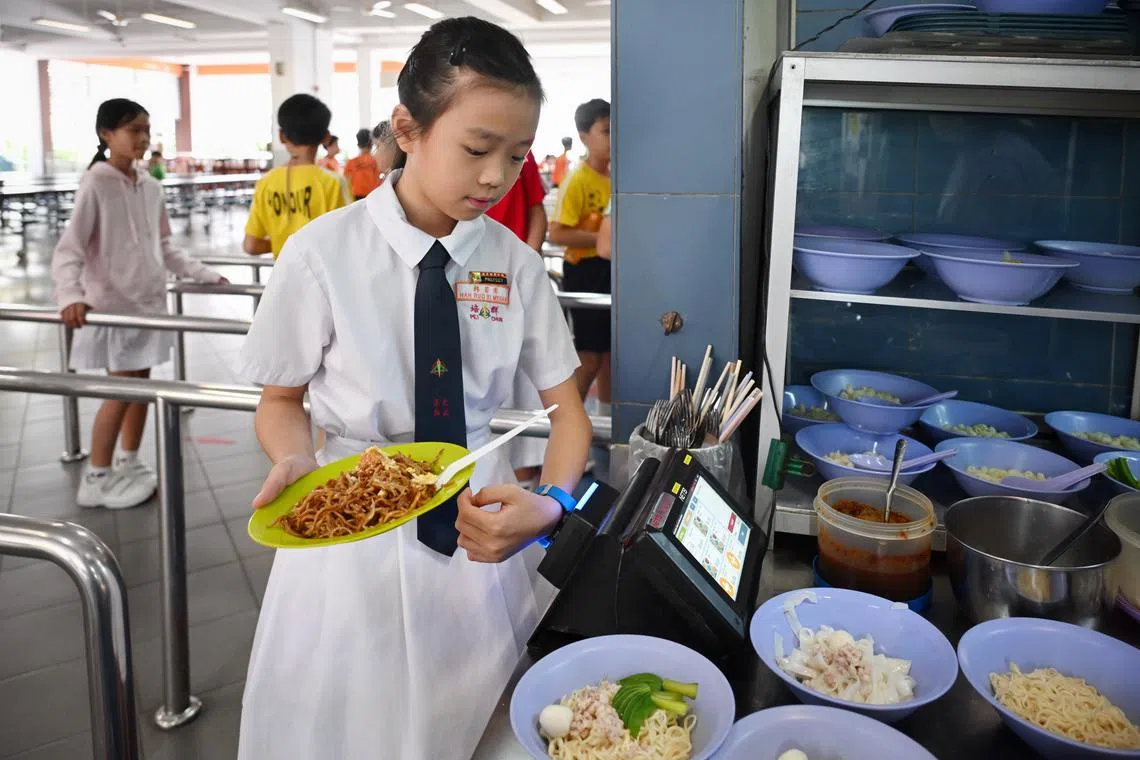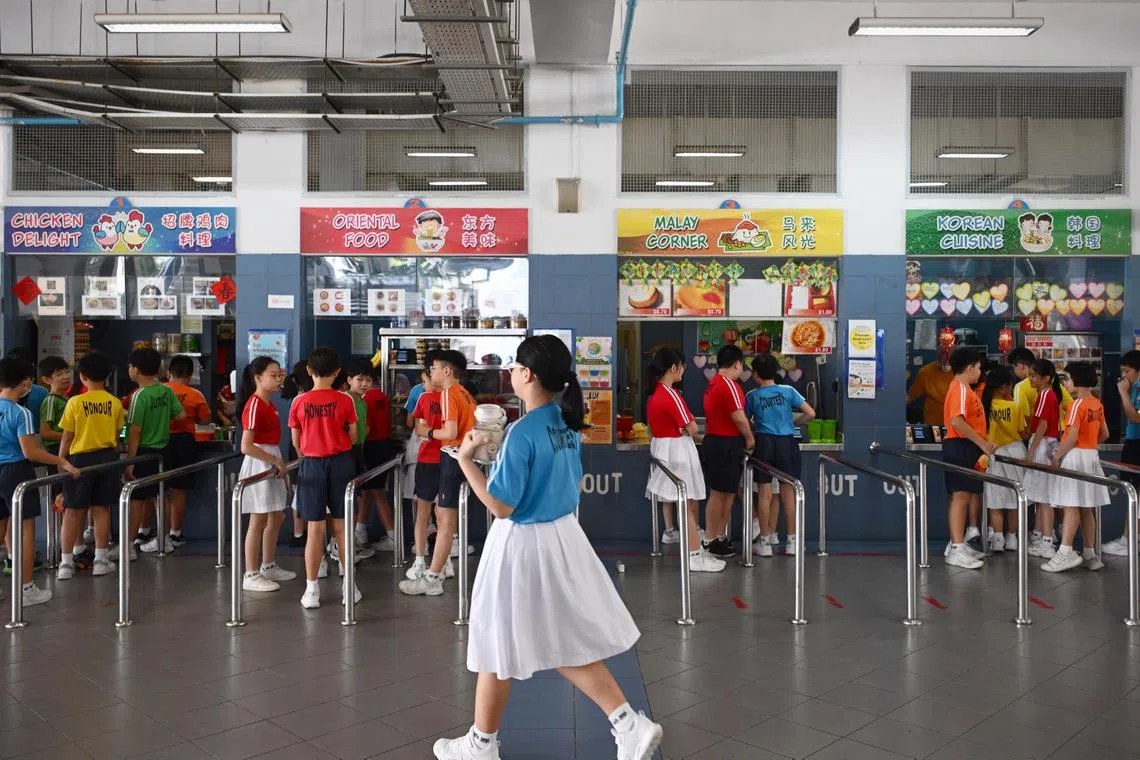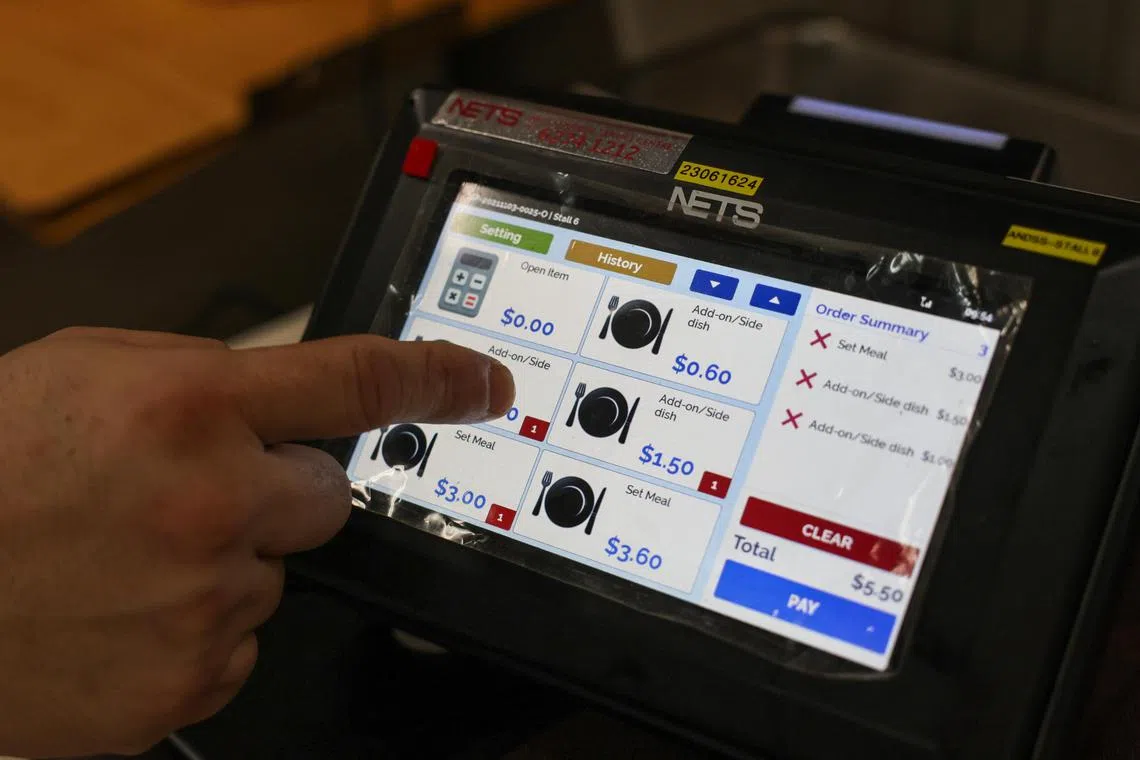Students in S’pore schools embrace switch to e-payments, welcome speed and ease of transactions
Sign up now: Get ST's newsletters delivered to your inbox

Pei Chun Public School pupil Megan Han, 10, paying for her food at her school canteen using her POSB Smart Buddy watch.
ST PHOTO: KUA CHEE SIONG
Follow topic:
SINGAPORE - Primary 5 pupil Megan Han picked out a plate of fried noodles at recess time, gently tapped her smartwatch against a digital terminal at the canteen stall and paid for her food within seconds.
The 10-year-old from Pei Chun Public School is one of more than 230,000 students nationwide moving towards the use of e-payment methods when buying food or stationery at school canteens and bookshops.
Students and canteen vendors whom The Straits Times spoke to said speed and ease of use were among the reasons for adopting e-payment methods – key factors that come into play during a brisk 30-minute recess period.
Megan said: “It reduces the queues at the canteen.”
Mr Keith Loh, 51, who runs an economy rice stall at Anderson Secondary School, said he liked the time-saving benefits of e-payments. As students need time to eat, he completes the bulk of the meal service in the first 10 minutes of recess time.
He said: “Paying in cash or coins may cost us more time to count and change money – even if it is just 10 or 30 seconds. But if it is machine-led, students can just scan and go.”
Mr Loh added that the payment terminal is also easy to use, for instance, when stallholders need to tote up the total cost of a student’s meal.
He said: “For example, if they don’t want a set meal but want meat, seafood, two vegetables and one serving of rice, I just have to press the right buttons and the price will be displayed.
“This helps me serve a lot more kids.”
The move to adopt e-payments in schools is part of the POSB Smart Buddy programme, a tap-and-pay initiative first launched in 19 primary schools in 2017.
The aim was to get more children to become familiar with digital payments and financial literacy.
In 2022, the Ministry of Education (MOE) and local lender POSB inked a deal
Latest figures show that more than 70 per cent of all MOE schools have come on board, POSB said in response to queries. That includes 80 per cent of primary and secondary schools, and 15 per cent of junior colleges and the Millennia Institute at last count in December 2024, MOE said in an e-mail reply.
It said: “For the older students in junior colleges and Millennia Institute, some of them were already using other e-payment options in their schools prior to the roll-out of the POSB Smart Buddy Programme, which also fulfils our objective of providing e-payment solutions across all schools.”

The swift processing of e-payments can help to reduce the queueing time for students during recess.
ST PHOTO: KUA CHEE SIONG
At every school that has adopted the programme, an average of eight payment terminals were installed, as well as two terminals that could be used to check account balances.
Aside from the Smart Buddy smartwatch or card, other forms of e-payment – such as school smartcards, ez-link cards, Nets FlashPay, and POSB or DBS ATM cards – can also be used at the school payment terminals.
That means students can use the same payment method for their different needs.
Clinton Tan, 13, a Secondary 1 student at Anderson Secondary, uses his ez-link card to pay for both public transport and canteen meals.
“I find it easier to budget if I just put all the money to be spent on this card,” he said.
Students from low-income households can also benefit from the e-payment scheme. Pei Chun Public School, for instance, is among the schools that tap the e-payment system to disburse financial aid, and do so discreetly.
Pei Chun principal Ong Lee Choo said: “In schools without the scheme, students receiving financial aid may have to sign off to make a purchase at stalls, or some schools use coupons – and sometimes students may not be very comfortable with that.”

The digital payment terminal helps stallholders tabulate the total cost of a meal, saving them the effort of doing the calculations manually.
ST PHOTO: GIN TAY
But the programme does have some disadvantages, said some canteen stall vendors.
One gripe is that vendors may not receive their earnings from e-payments immediately, unlike when students pay in cash.
Mr Loh said: “Sometimes we make a sale on Friday, and get payment on Monday, so cash flow is a problem.”
He said some school canteen vendors may be tight on cash due to their commitment to selling food at affordable prices.
Students could also unknowingly spend more when they use e-payments, he noted.
Mr Loh said: “On Mondays, Tuesdays and Wednesdays, when students’ cards or watches are full – they may tend to eat more food.
“But on Thursday, when there isn’t sufficient balance, they may ask me to reduce the number of items on the plate. They don’t think about the amount spent, which is the problem.”
To encourage students to save, POSB is rolling out workshops on basic financial concepts for at least 100 MOE-run primary schools and pre-schools, benefiting between 40,000 and 50,000 students, as part of a national savings drive launched by the bank in July 2024
So far, POSB has hit more than half of its target, reaching about 28,000 primary and pre-school students.
Anderson Secondary principal Tan Po Chin said the uptake of the Smart Buddy programme has been gradually increasing since the school rolled it out in 2023, though it is “not as pervasive as it could be”.
She estimated that one in two students at the school uses e-payments, and said plans to roll it out in schools nationwide are a step in the right direction.
Ms Tan said: “We believe strongly in the value of e-finance. When schools offer the option of e-payments, we start to nudge the behaviour of using them, and those who are ready and willing are able to do so.”


